Naegleria fowleri, commonly referred to as the brain-eating amoeba, is a microscopic organism that thrives in warm freshwater.
While infections are extremely rare, they are almost always fatal.
This blog covers the facts you need to know about this amoeba, where it is commonly found, and what precautions you can take to protect yourself when enjoying lakes, rivers, and hot springs.
We frequently visit these beautiful places during our travels, and it’s crucial to understand the risks and how to stay safe while appreciating them.
Plus, there’s another surprising way to contract this infection without steeping foot in the water-keep reading to find out more.
Save and Share this article to stay safe from Naegleria fowleri
What Is the Brain-Eating Amoeba?
Let’s take a closer look at what Naegleria fowleri is and how it leads to infection.
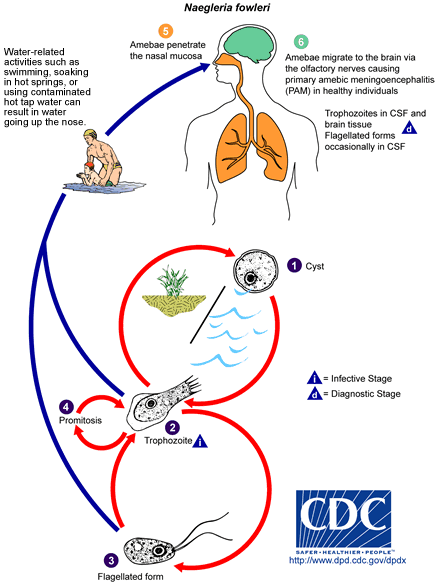
Understanding Naegleria fowleri
The brain-eating amoeba, scientifically known as Naegleria fowleri, is a single-celled organism that lives in warm bodies of freshwater, such as lakes, rivers, and hot springs.
It is typically harmless when ingested but can cause a fatal infection if it enters the body through the nose.
Once it enters the nasal passages, it can make its way to the brain, where it causes severe brain infection known as Primary Amebic Meningoencephalitis (PAM).
How Brain-Eating Amoeba Causes Infection
Infections occur when contaminated water enters the nose, allowing the amoeba to travel to the brain.
Activities such as diving, swimming, or any water-related activity in warm freshwater can lead to exposure.
However, it’s important to note that this amoeba does not spread through person-to-person contact or by drinking water.
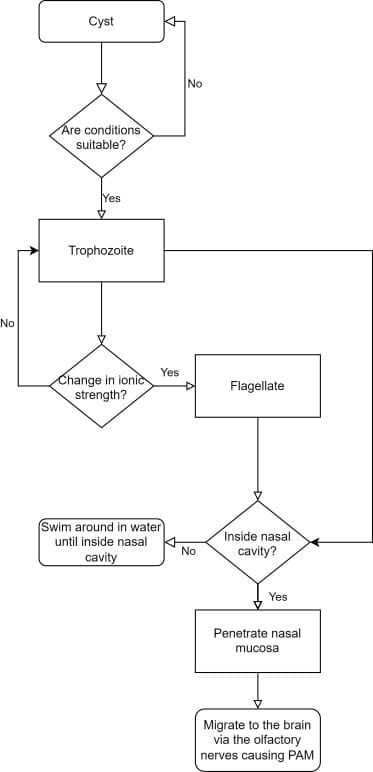
Where Is Naegleria fowleri Found?
The amoeba is most commonly found in warm freshwater environments, including lakes, rivers, and geothermal hot springs.
It thrives in water temperatures above 77°F (25°C), especially in stagnant water during the warmer months.
While very rare, improperly chlorinated swimming pools or water systems can also harbor brain-eating amoeba.
The Amoeba is not found in true saltwater environments, such as oceans.
Hot Springs and Brain-Eating Amoeba Cases: What You Need to Know
Hot springs are a popular destination for travelers seeking natural relaxation and scenic beauty.
However, it’s important to be aware that some of these warm, mineral-rich waters can host the brain-eating amoeba (Naegleria fowleri).
This amoeba thrives in hot environments, including hot springs, particularly those with stagnant water or areas where temperatures are ideal for its growth.
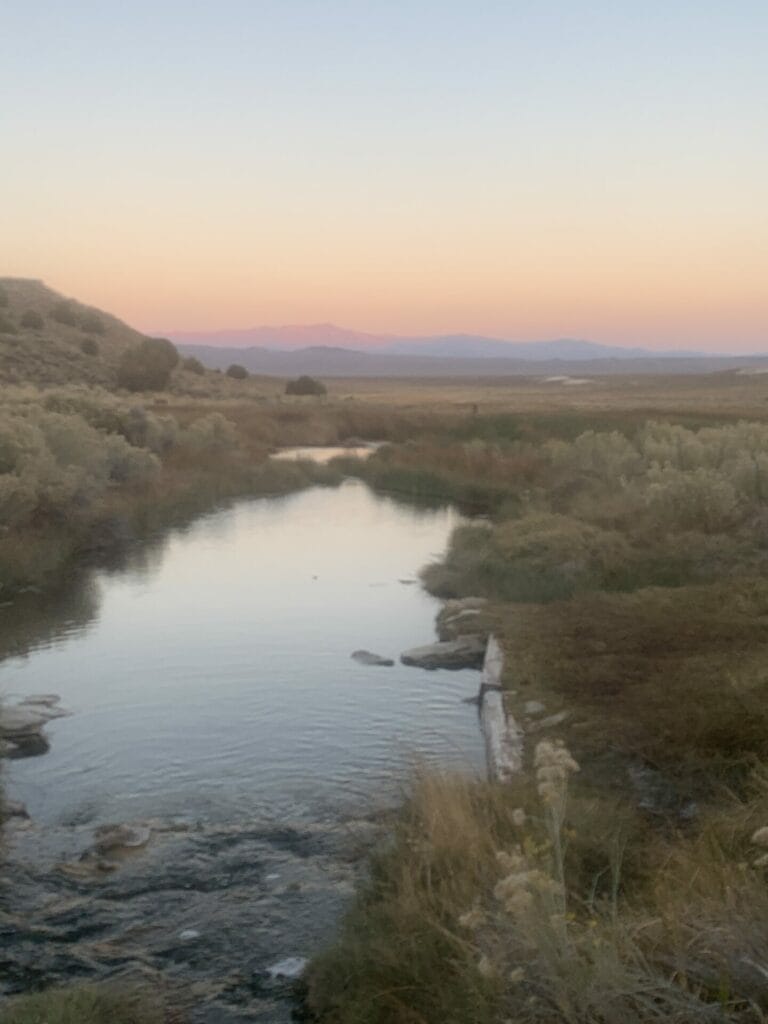
As hot spring enthusiasts ourselves, we make it a priority to reduce the risks while continuing to enjoy these incredible locations.
Knowing how to stay safe allows us to experience their beauty without unnecessary worry.
If you’re interested in discovering some of the best hot springs across the U.S., check out my blog on hot springs we’ve visited.
While we always take precautions, we find that understanding the risks and knowing how to minimize them allows us to enjoy these beautiful destinations safely.
Hot Ditch, Inyo County, California
In 2018, an 8-year-old boy contracted Naegleria fowleri at Hot Ditch, a natural runoff from Keough Hot Springs.
At the time, the stagnant, warm water created an ideal environment for the brain-eating amoeba.
Arizona Hot Springs, Colorado River, Nevada
Another tragic case occurred in 2013 at Arizona Hot Springs near the Colorado River, where a young boy was infected with the brain-eating amoeba.
Warmer water temperatures in this area posed a risk for the deadly microorganism.
Ocean Incidents and Brain-Eating Amoeba: Mixing Salt and Fresh Water
While Naegleria fowleri primarily thrives in warm freshwater, there have been incidents where people contracted the amoeba after spending time near oceans or estuaries where saltwater and freshwater mix.
Florida’s Brackish Water Risks
In regions like Florida, many bodies of water consist of a mix of saltwater and freshwater, known as brackish water.
Though Naegleria fowleri doesn’t survive in pure saltwater, brackish water can still create favorable conditions for the amoeba, especially in estuaries, rivers, and areas near the ocean that experience freshwater inflows.
For example, rivers that feed into the ocean in Florida provide the warm, nutrient-rich environments that allow this microorganism to thrive.
If someone swims in these areas, the risk of contracting brain-eating amoeba can still exist.
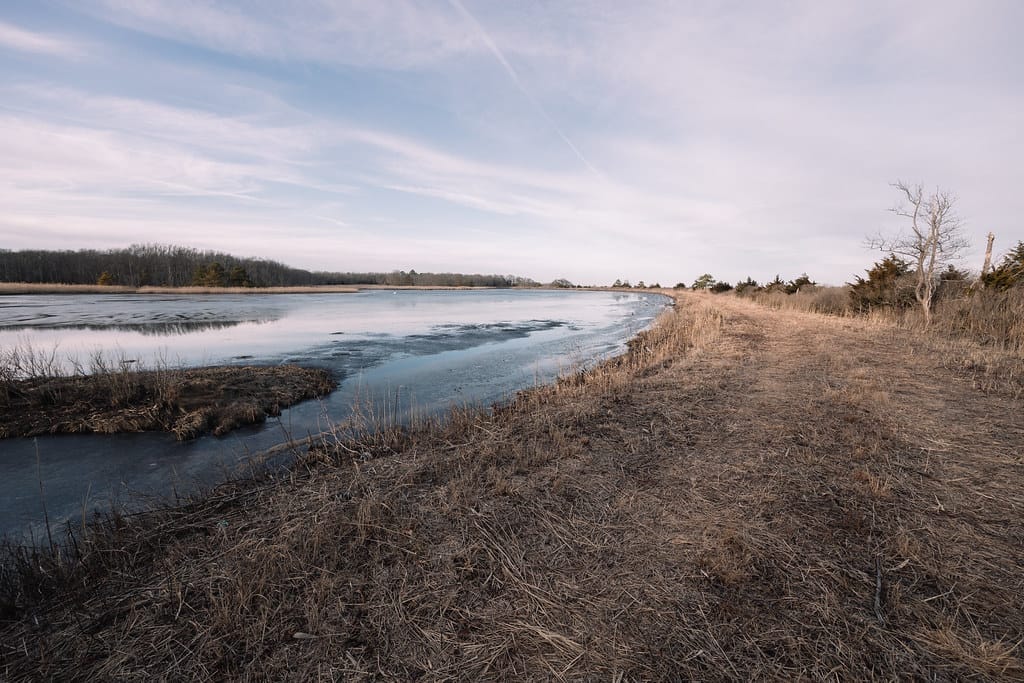
Suspected Cases Near Ocean Waters
Though there are no confirmed reports of brain-eating amoeba infections directly from ocean water, there have been instances where individuals spent time in both freshwater and ocean areas during their illness.
It’s believed that these cases likely stemmed from freshwater exposure, especially in rivers or lakes, rather than the ocean itself.
Warm and stagnant freshwater, even when it’s near an ocean, poses a significant risk.
Reported Naegleria fowleri Cases and Statistics
Before diving into the statistics, it’s important to highlight that while Naegleria fowleri infections are rare, they can occur through various routes, not just through freshwater exposure.
One notable method of contraction is through nasal irrigation, particularly when using non-sterile water.
Understanding the broader context of how infections can happen helps frame the statistics and underscores the need for vigilance in all situations involving water exposure.
Tracking Naegleria fowleri cases across the U.S. helps identify patterns and raise awareness of potential risk areas.
A large proportion of reported cases of infection had a history of water exposure, 58% from swimming or diving, 16% from bathing, 10% from water sports such as jet skiing, water-skiing and wakeboarding and 9% from nasal irrigation.
State Breakdown of Cases in the U.S.
Infections are incredibly rare but typically occur in warmer states.
From 1962 to 2022, there have been 157 reported cases of Naegleria fowleri in the United States, with most of these cases being fatal.
The states with the highest number of cases include:
- Texas: 39 cases
- Florida: 37 cases
- California: 10 cases
- Arizona: 7 cases
- Louisiana: 7 cases
- Arkansas: 6 cases
- North Carolina: 6 cases
Other states like South Carolina, Oklahoma, and Nevada have also reported cases.
The vast majority of these infections occurred in southern states where warm temperatures promote the growth of the amoeba.
Florida and Texas, in particular, have experienced the highest concentration of cases, likely due to their extensive freshwater lakes and warm climates.

There have been isolated cases in northern states like Minnesota and Nebraska, usually tied to heatwaves or unusual temperature spikes in freshwater lakes.
Note: The true number of cases is likely to be higher than those reported due to problems relating to diagnosis, access to diagnostic testing and a lack of surveillance.
How to Prevent Brain-Eating Amoeba Infection
The good news is that brain-eating amoeba infections can be prevented.
Understanding the simple steps to avoid exposure while enjoying water-based activities can significantly reduce the risk.
Simple Tips for Reducing Your Risk
While infections are rare, prevention is key:
- Keeping the head above freshwater.
- Avoid getting water up your nose when swimming, diving, or playing in freshwater.
- Do not jump or dive into warm fresh water.
- Wear nose clip when you’re in warm, stagnant water.
- Stay out of freshwater sources when temperatures are high, especially during the summer when the risk is higher.
- Don’t stir up sediment when swimming, as the amoeba may reside there.
- When irrigating sinuses, it is advised to use boiled or distilled water.

Be Cautious with Neti Pots
While neti pots are often used for nasal irrigation to relieve congestion and sinus issues, they can pose a risk for Naegleria fowleri infection if not used properly. Using tap water instead of distilled or sterile water in neti pots can introduce the brain-eating amoeba into the nasal passages. This organism can then travel to the brain, leading to severe and often fatal infections.
To minimize this risk, always ensure you use distilled or sterile water in your neti pot. Additionally, boiling tap water for at least one minute can make it safe for use. By taking these precautions, you can safely enjoy the benefits of nasal irrigation without exposing yourself to unnecessary risks.
What to Do After Potential Exposure
If you’ve been in a high-risk body of water, monitor for early symptoms such as headache, fever, nausea, and neck stiffness.
The infection progresses rapidly, so seeking immediate medical attention is critical if symptoms appear.
Successful treatment of PAM is rare; treatment can only be attempted after correct diagnosis, which relies on rapid recognition of the microorganism by medical technologists and pathologists.
It is critical that medical technologists consistently provide timely evaluation, explore the diagnosis of PAM, and look for amoebae inflammation of the membranes that protect the brain and spinal cord, especially in summer.
Recognizing Naegleria fowleri Symptoms
Early detection of brain-eating amoeba infection is crucial for treatment.
Knowing the symptoms of infection can help individuals seek medical care promptly, which is key to improving outcomes.
Early Signs of Infection
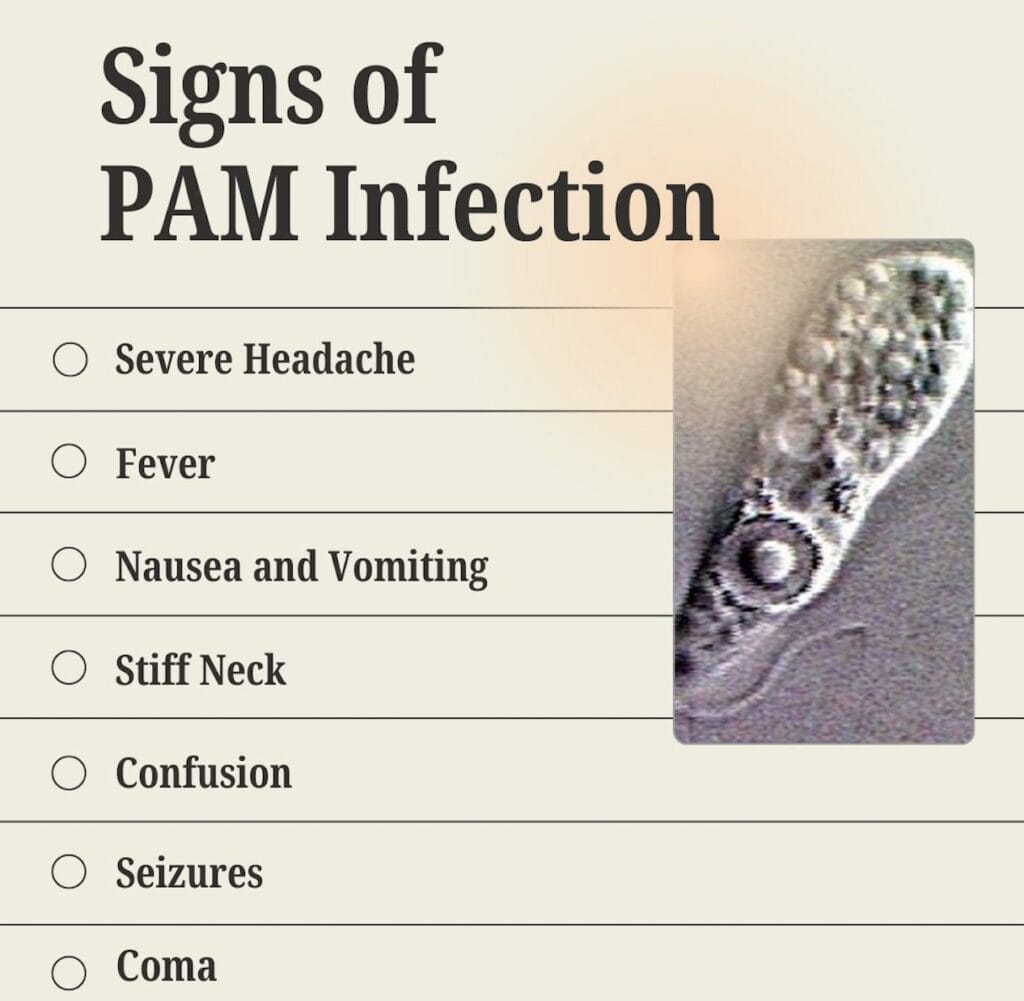
The early symptoms of Primary Amebic Meningoencephalitis (PAM), caused by Naegleria fowleri, are often similar to other common illnesses, making it difficult to detect.
Typically, symptoms appear 1 to 9 days after exposure.
Early symptoms include:
- Severe headache
- Fever
- Nausea and vomiting
- Stiff neck
These early signs can quickly escalate, leading to confusion, seizures, and even coma.
How Fast Does Brain-Eating Amoeba Progress?
Once symptoms start, the disease progresses rapidly, often leading to death in 5 days, on average.
Early detection and treatment are essential, but due to the rarity of the infection, diagnosis is often delayed.

Should You Be Worried About Swimming in Freshwater?
Given the presence of brain-eating amoeba in warm freshwater, it’s natural to wonder how much of a risk swimming in lakes or rivers poses.
In this section, we’ll evaluate the likelihood of infection and provide safety recommendations for water activities.
Assessing the Risk in Lakes and Rivers
While the idea of a brain-eating amoeba sounds alarming, it’s important to remember that infections are exceedingly rare.
Out of the millions of people who swim in freshwater lakes, rivers, and hot springs every year, only a handful of cases are reported.
The key to staying safe is understanding the conditions that increase the risk and taking appropriate precautions.
Water Safety in Lakes: What You Need to Know
While warm and stagnant freshwater bodies are the most common sources of Naegleria fowleri, fast-moving water or colder bodies of water typically do not harbor the amoeba.
By choosing your swimming spots wisely and being aware of the conditions, you can reduce your risk.
Can dogs get Brain-Eating Amoeba infections?
It’s not just humans who can be at risk of Naegleria fowleri infections—Animals may be infected by Naegleria fowleri.
Dogs, too, can be affected by the brain-eating amoeba.
For dog owners who love outdoor activities with their pets, understanding the risk is important.
Are dogs at risk of contracting Naegleria fowleri?
Yes, dogs can contract brain-eating amoeba, though cases are rare.
Like humans, dogs are exposed to the brain-eating amoeba when they swim in warm freshwater, especially in lakes or ponds with little movement.

How to Keep Your Dog Safe
When enjoying the outdoors with your dog, especially in warm climates, there are a few key ways to help prevent exposure to the brain-eating amoeba:
- Avoid letting dogs swim in warm freshwater: During warmer months, avoid lakes, rivers, or hot springs where water temperatures are high, as this is where brain-eating amoeba thrives.
- Stick to clean, treated water sources: Opt for swimming in controlled areas like dog-friendly pools or cooler freshwater streams.
- Prevent nose immersion in risky waters: Naegleria fowleri infects through the nose, so discourage your dog from submerging their nose in untreated freshwater.
- Monitor water conditions: Be mindful of any advisories or warnings about local water conditions, especially in the summer.
By following these safety tips, you can ensure that your dog enjoys the outdoors without the unnecessary risk of infection from the brain-eating amoeba.
Trusted Sources and Further Reading
When discussing health-related topics, it’s crucial to use reliable sources of information.
Below are some key references and trusted organizations that track and provide detailed information on Naegleria fowleri, waterborne pathogens, and public safety guidelines:
1. Centers for Disease Control and Prevention (CDC)
- The CDC provides comprehensive data on Naegleria fowleri, including the number of cases in the U.S., the breakdown of cases by state, and information on confirmed incidents in lakes, rivers, hot springs, and other freshwater sources.
2. U.S. Geological Survey (USGS)
- The USGS tracks waterborne pathogens and incidents in bodies of water, including hot springs. They have information on environmental conditions that could support Naegleria fowleri growth.
3. Peer-Reviewed Research Papers
- Some scholarly sources have detailed breakdowns of specific incidents and case studies, including treatment and progressions. These papers provide case analysis and environmental conditions that supported the infection.
4. National Library of Medicine (NLM)
- The NLM hosts several articles that discuss Naegleria fowleri infections, epidemiology, and survival in different environments, including U.S. case breakdowns and how environmental factors contribute to outbreaks.
5. Florida Department of Health
- For specific incidents in Florida’s brackish waters, the Florida Department of Health provides regional data and warnings about Naegleria fowleri in freshwater and mixed water systems.
Conclusion: Staying Safe in the Water
To embrace the simple bliss of nature while enjoying lakes, rivers, and hot springs, it’s essential to prioritize your safety.
By staying aware and practicing prevention—such as avoiding water activities that could cause water to go up your nose and being cautious with nasal irrigation—you can reduce the risks associated with Naegleria fowleri.
While infections are rare, knowledge is power, and together we can ensure a safer experience in these beautiful environments.
Share this information with friends and family, and let’s enjoy life’s simple pleasures without worry.

Save and Share this article to stay safe from brain-eating amoeba
Photo credit:
- By Cle4tle – Own work, CC0, Link ↩︎
- “Coastal brackish water impoundment” by reclaimednj is licensed under CC BY-SA 2.0 ↩︎
- “Mark’s Orange Dog Swimming” by Mr Moss is licensed under CC BY 2.0 ↩︎

Leave a Reply